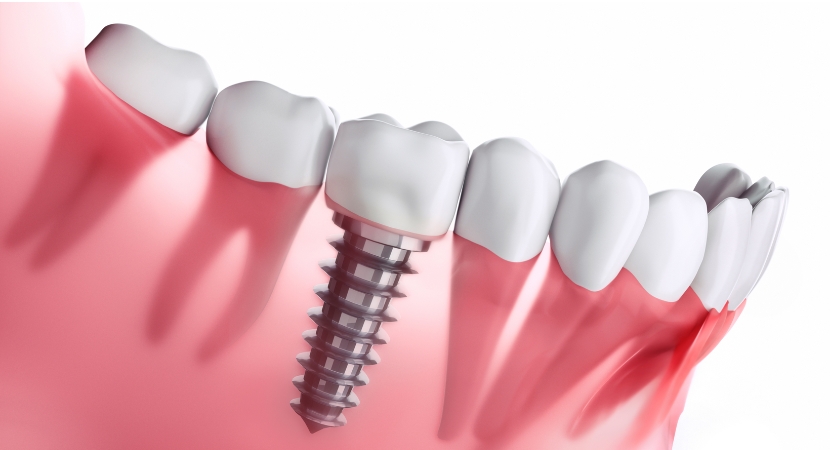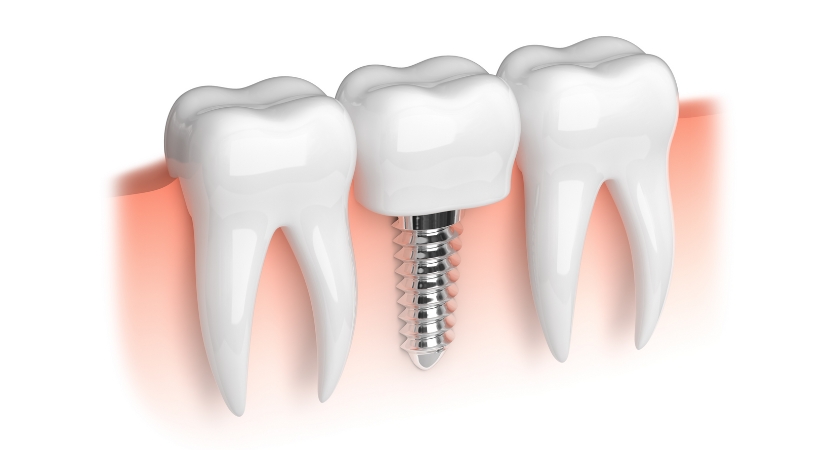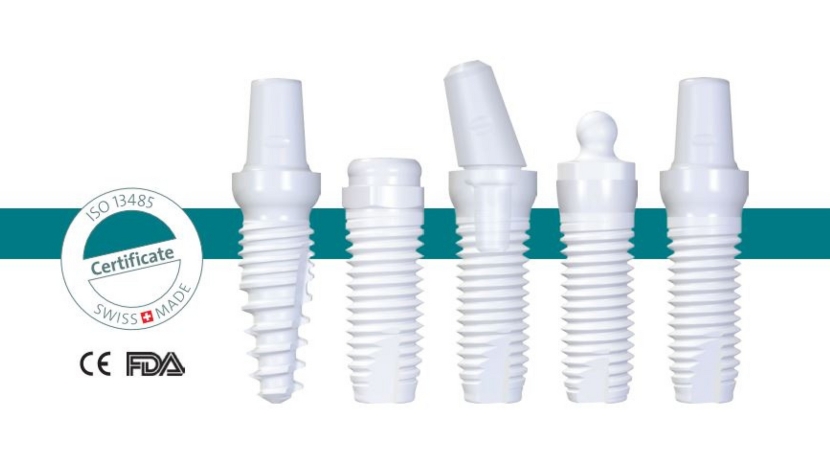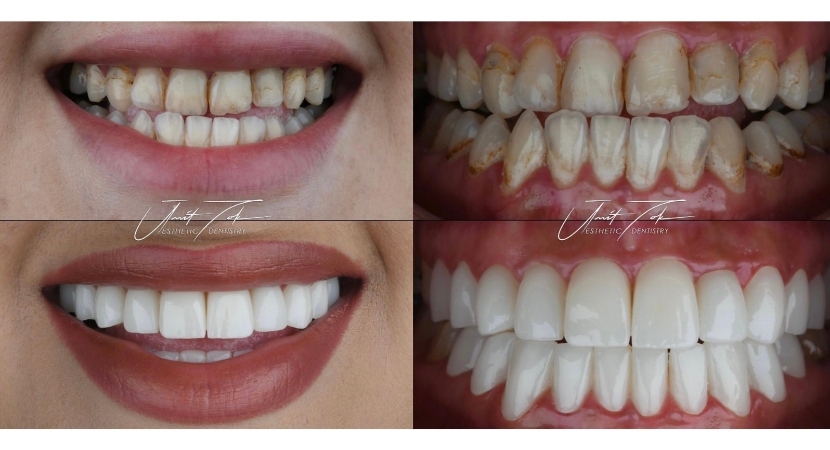
Implant Treatment
Implant treatment is an innovative dental procedure that allows you to replace lost teeth. This treatment method is preferred for addressing aesthetic and functional issues resulting from the loss of natural teeth. Titanium screws are placed to replace the extracted missing tooth roots. Then, artificial teeth with the same color and appearance as natural teeth are attached to these screws.

Who is suitable for Implant Treatment?
It can be applied to anyone over 18 years old, has sufficient jawbone, and does not have wound healing problems. In general, this is an ideal treatment option in the following situations:
• If you have one or more missing teeth
• If you have reached the age of bone development
• If you have enough jawbone to support the implant (bone grafting may be applied if there is osteoporosis)
• If you do not have a health problem that may hinder bone fusion (uncontrolled diabetes, etc.)
• If you complain of instability with removable dentures
• If you do not want natural teeth to be filed down when placing a bridge
• If you can wait a few months for the treatment to be completed
• If you can limit smoking and tobacco use
Types of Treatment
The types of implants and treatment methods have undergone many different design changes over time. Nowadays, endosseous implants are often preferred and provide highly successful treatment for various dental deficiencies:
Single Missing Tooth
The implant is placed in the space created by the extracted tooth, due to trauma or decay. This screw replaces the natural root of the tooth, and then a crown is attached to it. In bridgework treatment for teeth, which is an alternative to implant treatment, the natural teeth adjacent to the gap must be filed down. Matching colors is easier for a single tooth, providing highly aesthetic treatment.
Multiple Missing Teeth
In cases where several teeth are missing next to each other, an implant is placed at each end of the space. Then a bridge is established between these implants. These implant-supported bridge prostheses, which have a structure similar to a dental bridge, are fixed to implants, not to natural teeth. This achieves harmony and unique durability that is not possible with other treatment methods.
Complete Edentulism
For stable treatment of a completely edentulous mouth, 6 implants are placed in the lower jaw and 7-8 implants in the upper jaw. Then a fixed bridge is attached to these implants. In the treatment of a completely edentulous mouth with a removable prosthesis, 2-4 mini implants are placed in the front part of the lower or upper jaw. The removable palate prosthesis is attached to these implants, thus preventing their mobility. In recent years, All-on-4 implantation has become very popular. This is an approach to semi-fixed prosthetic treatment. A hybrid prosthesis is made on the same day over 4 angular implants placed in the front part of the jaw.

How Implant Treatment is performed?
How should you prepare?
The most important part of the implant treatment process is the preparatory phase and treatment planning. Because successful treatment is only possible within a well-developed plan.
Taking Medical History
Provide your doctor with detailed information about the medications you use and your current health condition. If you have a heart condition, a history of bypass surgery, or orthopedic disease, you may need to use antibiotics before treatment.
Comprehensive Examination of the Oral Cavity and Teeth
Before treatment, it is first determined that your jawbone has sufficient thickness and height to support the implant. For this purpose, panoramic X-rays of the jaw or 3D dental tomography are used. In addition, treatments that help maintain oral hygiene, such as gum recession and osteoporosis treatment, should be completed before treatment. For patients undergoing orthodontic treatment with braces or clear aligners, these treatments should be completed before implant placement.
Treatment Plan
Based on the data obtained, the doctor determines which teeth will be extracted and how many implants need to be placed.
Implant surgery is a painless and simple surgical procedure that is usually performed under local anesthesia. However, for anxious and fearful patients, implant placement with sedation and general anesthesia may be preferred.
Stages of Implant Treatment
This is a process that unfolds in several stages: surgical intervention, recovery period, and prosthetic phase. The treatment takes several months from start to finish and involves multiple stages, including:
• Extraction of the damaged tooth before implantation
• Application of bone powder
• Placement of the implant
• Fusion of the jawbone and the screw (healing period)
• Placement of the recovery cap
• Attachment of the abutment and prosthetic tooth
When is Bone Powder necessary?
In implant treatment, if your jawbone is not sufficiently strong to support the implant, it may be necessary to apply bone powder. Since the implant must be surrounded by hard bone to withstand the loading and pressure that occurs during chewing. Grafts used in the treatment of jawbone loss and associated tooth loss can be taken from another part of the mouth or can be of animal origin, or synthetic.

How Long Does Implant Treatment Take?
In the traditional approach, the duration of implant treatment is usually 2 months for the lower jaw and 3 months for the upper jaw. However, due to the latest technological developments in the implant industry, there are implants with surfaces coated with special substances that allow for faster completion of treatment. With immediate implants suitable for rapid loading, it is possible to achieve one-stage treatment with permanent implants in one day. Additionally, additional procedures such as applying bone powder during treatment lead to an extension of the treatment period by 3-4 months.
Bone deficit is quite common, especially in the posterior teeth of the upper jaw, due to the elevation of the floor of the maxillary sinus. In such cases, sinus floor elevation may be required along with implant treatment, and the recovery period can take up to 6 months. In cases of long-term implantation, your dentist may recommend the use of temporary teeth for aesthetic and functional reasons. In cases where the jawbone does not allow such a procedure, a zygomatic implant may be preferred as an alternative.

Implant Placement
During the implantation surgery, the oral and maxillofacial surgeon makes a small incision in the gum, reaches the bone, and prepares a gap for the screw to enter. Then, the implant is placed into the bone, and the gum is stitched up. The surgical wound usually heals within a week.
Bone Fusion and Implant (Osseointegration)
After the implant screw is placed in the jawbone, the healing period, called osseointegration, begins. During this process, the jawbone grows towards the surface of the implant and fuses with it. This period is usually 2 months for the lower jaw and 3 months for the upper jaw. For aesthetic and functional reasons, your dentist may sometimes prepare a temporary tooth during this process.
Placement of the Recovery Cap
After completing osseointegration, a healing cap, called a gingival former, is attached to the implant. This part ensures that the gum tissue around the implant is shaped and heals properly.
Attachment of the Abutment and Prosthetic Tooth
To do this, the dentist takes measurements of the implants using an impression and sends it to the dental laboratory. The prosthetic fixed or removable prosthesis supported by implants is fixed with permanent adhesive to the abutments.

What to Expect After Implant Surgery?
Before implant surgery, your doctor will thoroughly explain the following situations you may encounter during and after the treatment process. After a typical operation, the following symptoms may occur:
• Bleeding after the surgery
• Pain in the area of the operation and the gums
• Bruising on the face, under the eyes, and the neck area
• Swelling of the gums and face
These symptoms that occur after implant surgery are entirely normal and usually disappear within a few days. You should regularly use the antibiotics and pain relievers prescribed by your doctor and eat warm and soft food for several days. If your doctor has not used soluble stitches, you will need to remove the implant stitches after 7 to 10 days.

Risks and Complications
Implant therapy is a safe dental procedure that has been used by dentists and surgeons worldwide for decades. However, the application carries various risks that can be managed. Depending on the condition of each patient, potential risk factors may vary:
• Poor oral hygiene or limited wound healing due to pre-existing medical conditions (such as diabetes and osteoporosis) make the implant less likely to stay in place.
• If an infection develops in the bone socket where the implant is placed, it may fail to integrate properly.
• Damage to blood vessels and nerves in the vicinity of the application area is possible. Nerve damage that cannot be treated may cause numbness.
• In the case of implantation in the upper jaw, injuries to the maxillary sinus may occur.
Implant therapy is the safest treatment method you can choose to replace missing teeth, but it is essential to consider and manage these potential risks based on individual patient conditions.


